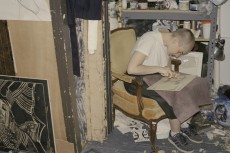NY Issue : Interview with Katya Zvereva
NeoL / 2017年12月19日 22時8分
自分の背丈以上もある大きな木版画を次々と精力的に生み出しているatya Zvereva。日本に由来した手法を極め、ナイフのストロークやプリントの素材探しなど様々な挑戦を日々続けている彼女の、凛と伸びた背筋はその作品同様に美しい。
——子供の頃から絵が好きだったそうですが、木版画にはどうやって辿り着いたのですか?
Katya「2年前に始めたばかりなんだけど、それも偶然でした。元々は建築の修士号をとっていたのですが、もっとアートを学びたいと思って、New York Academy of Artに通うためにNYに来ました。最初はペインティングを勉強していたけれど、あまり好きじゃないことに気づいて(笑)。その時、偶然版画の授業をとっていたのです。教授のJohn Jacobs Meyerは本当にいい人で、版画の全てを見せて教えてくれました。版画は自分に合っていると気づいて、版画を作っているアーティストやそのテクニックも調べ、版画を知って自分の世界が広がったように思います。2年間でいろんな大きさとスタイルの150個以上の作品を作りました。最初は偶然勢いで始めたんだけど、『これが私がやりたいことだ!』と気づいたのです。一目惚れみたいな感じですね。簡単な作業に見えるけど、いろんなナイフで木を掘っているし、いろんなファブリックに版画をプリントしています。私が使っているのは13世紀の日本で始まった方法で、水性と油性のインクを使うもの。マイナーな本で偶然見つけた作り方なんです。前は油性のインクで、縫い合わせたファブリックに印刷していたのですが、縫い跡が嫌いだったから、縫わずに似た感じのものを作れる方法を探していた時にこの方法を発見しました。水性のインクを刻板に大量に塗って、水を塗って、布を敷いて、その上を歩くまたはローラーを転がすんです。それで縫わずに2.5 x 2.5 メートルの作品を作れるようになりました。友達には、日本の技術で、ブラックの人々をプリントしているのねとからかわれた。つまり、アートも他のものも世の中にボーダーがなくなってきたということです」
——昔の絵の作品はいろんな色を使っていたのですが、今はモノクロの作品が多いですね。なぜ変わったのでしょうか。
Katya「ただシンプルな色が好きなだけなんです。でも、もうちょっと色を取り入れて、3、4色ぐらい使ってみようかなとも思っています。自分が色のトーンの識別が苦手だということにも、ペインティングをしていて気づきました。青色が全部同じに見えるのが一番の問題。だから、モノクロやシンプルな色が好きです」
——白と黒を使う意味をどう考えていますか。
Katya「色よりテクスチャーですね。絵と同じで、ナイフのストロークによってイメージは変わります。掘り方によっては光の筋を入れることができるので、もっと取り入れようと思っています。ペインティングでは色のコントラストだけど、版画では掘り方とツールの使い方が全てなんです。でも私の作品のほとんどはもっと二次元的で極々シンプルなものですけどね」
——なるほど。これは布を重ねてあるんですよね。
Katya「ええ、布を何枚も重ねています」
——新しい手法をいつも探しているんですか。
Katya「研究しているけど、極めて自然にやっている感じです。決めたテクニックの中でいろいろ試しているので、オイルを使ったりはしていません。一つの技術に集中して、誰も作ったことないような作品を作ろうとしているんです。あなたが私の作品を見た時にどうやって作ったか気になるように、私も他の人の作品を見た時にすごく気になります。アートを通して、人とコミュニケーションを取りたいから、興味を持ってもらいたい。だから見る人にとってゲームのような作品を作ることができたらと思っているんです」
——自分の見ているものをどのように作品に反映しているのでしょう。
Katya「今は誰も作ったことのないような作品の作り方を考え中なので、あまり反映してはいないと思います。前シリーズは制作に1年以上かかったのですが、教会でエキシヴィションをやりました。それはもっと自分の人生と恋愛観に繋がっていたかな。自分の周りにあるものって何だろうと考えていました、愛、人生、友情、リレーションシップのようなね。私は敬虔ではないけれどクリスチャンだから、人とコミュニケーションをとり、お祈りもできる教会でエキシヴィションをするというのはとてもシンプルなやり方だったんです。教会を予約するのに2ヶ月ぐらいかかったかな。そこで働いているいろんな人の前でプレゼンをして許諾を得ました。私の作品とインスタレーションだけではなく、ファッションショーや音楽のパフォーマンスもあったから、エキシヴィションというよりはイベントですね。インスタレーションはSex, War, Lifeの3段階にわかれていました。 愛のサイクルを表現していて、愛はSexから始まるから、3人がセックスしている12枚のパネルでその情熱さを伝えました。その次はwar。情熱が冷めて、もしかしたら同居生活が始まって、喧嘩が増えて、いろいろ疑い始める時期。わかりますよね? そして、二枚の長い6mのパネル。喧嘩を乗り越えてlifeが始まるのです。人生は複雑だけど、それでも努力を続けていること。そしてカップルについてというより、個人のアイデンティティやそれらのサイクルから得られるものについて描いています。自分を愛して、アイデンティティを探すことが全体のテーマ。すぐそばにあり、みんな常に体験していることをテーマにしたのです」
——壮大なテーマですね。作品がどんどん大きくなっているのはなぜですか。
Katya「ありがとうございます。上手く説明できないけど、イメージを感じとれないから小さい作品を作れないんです。ここにある一番大きい作品でも私にとっては小さいから、大問題なんですよね。自分の背丈より大きいサイズなのに。今はどのサイズがいいか試行錯誤しているところですが、何を作っても小さく感じて、どんどん作品が大きくなっていくんです。もっと広いスタジオに移ったら、自分が作れる最大の作品を作ります。このスタジオじゃ8 x 10フィート が限界かな。でも大きすぎる作品は売れないかもしれませんね(笑)」
——お話をうかがっていると、テーマが壮大だから作品自体も大きくないと描ききれないのかと思いました。
Katya「いつもアイデアは大きくあるべきだと思いますが、時折小さいものも作りますよ。この小さいのは習作なんです。小さな習作をプリントしながら、どうしていくか見極めるということをやっていて、何か違うことができないかなど常に考えていますね。そうやっていろんなレイヤーを重ねて作っていくんです」
——例えばプリントした布で洋服などを作ることもあるんでしょうか。
Katya「ええ。友達がデザイナーでCarolina Sarriaというブランドをやっているんです。教会のファッションショーでもコラボをしました。私が壁と同じ柄を生地にハンドプリントして、その布で友達が服を作ったんです」
——以前に大きな木に掘りたいって言っていましたが、今もそう夢見ています?
Katya「木のまわりを掘って転がして同じイメージの繰り返しにしたら面白そうだと思っていたのですが、まだ考え中です。作るにはもっと場所やいろんなものが必要ですから。今あるもうひとつのアイデアは”stealing images”。新鮮なセメントを見ると、人々は自分のマークを残したくなるから、街中にいろんな不思議な柄があるんです。だからセメントにインクを塗ってプリントするということを次のプロジェクトにしたくて。これは今すぐ始めるべきかな。とても美しいものになると思います。色々試してごらんといつも薦めてくれる友達がいて、ある日彼が『これで版画を作ってみれば』と斧を持ってきたんです。『ふざけてるの? これで何をすればいいの?』と聞いたら、『想像力を使えばいい』と言われました。そこからいろんなテクスチャーや掘り方について話して、私は地面にある全てのものを壁に飾りたいと気づいて。それはできないかわりに、インクを塗って盗むことを思いついたんですよ」
——とても面白いプロジェクトですね。関係ないけど、壁にある作品を長いこと見ていたら、段々曼荼羅に見えてきました。
Katya「私の一番大きな作品『Life』は、見た人によって感想が違うので、いつも新しいこと気づかされます。だから、見てくれる人とのコミュニケーションは大切。お互い新しいことを知っていく、アートを通しての会話ですよね」
——まさに。ところで、あなたは今のNYのアートシーンをどう見ていますか。
Katya「世界最大級のアートシーンだからいろんなギャラリーに素敵なアーティストが展示されていますよね。素晴らしいギャラリーもたくさんあるけれど、同時にデタラメなところも多い。ギャラリーにもランク付けがあって、場所代によって変わってくるんです。チェルシーの賃料を払えたら、多分高い作品が大量に売れているということ。それが払えなければ、ローワーイーストサイドやブルックリンや更に奥にいく。でも同時に、ブッシュウィックやウィリアムズバーグにも素敵なギャラリーがあります。ただ、若手アーティストの作品を取り扱っているからあまり儲からないんです。ローワーイーストサイドも似た感じですが、あそこにはチェルシーのギャラリーも結構移転しています。結局はキュレーターやギャラリーのセンス次第かな。センスが良い面白い人が運営していたら、ギャラリーは最高。でも、お金のことばかり考えているような人だと、アートとしては最低。見る側も大切だし、いろんな人が関わっているから複雑ですよね。今はギャラリーに置いてもらうことを目指しているけれど、本当はギャラリーより美術館でプロジェクトを行いたいと思っています。ギャラリーは売るのが目的だからスーパーみたいに思えて。でも、美術館でやるには、ギャラリーなどでの経験が必要ですからね」
——なるほど。ではいま進行中のプロジェクトと、最新のニュースがあれば教えてください。
Katya「2月に初めて個展を行います。個展ではここにあるものやセックスをテーマにした作品で、ここにあるようなレイヤーを重ねたものやポートレイトがメインになる予定です」
Katya Zvereva
http://www.katyazvereva.com
photography Diego Garcia
interview Ryoko Kuwahara
——So I know you’ve loved art since you were a child, but how you end up doing wood cuts?
My story is that I started doing large-scale wood cuts, just 2 years ago. It was an accident, because before that, I was a painter. Before that, I had my Master’s degree in Architecture. I was an architect, but then I decided I want to study more art. I decided to move to NY to go to art school at the New York Academy of Art. I started studying painting, but it didn’t work well because I realized I don’t like to paint at all. And I accidentally signed up for a class called Wood Cuts, and my teacher, his name is John Jacobs Meyer, is an awesome guy. He showed me everything, he showed me wood cuts, he told me all about the art history of wood cuts, and how they looked like. And it was exactly the kind of thing that I love. A lot of artists were doing the same technique and I was so obsessed with them. When I realized I can study this technique, it opened a whole new world. I’ve been making them for the past two years and during that time, I’ve made more than 150 pieces, in different sizes and styles. I started doing it very accidentally, just because, why not? And then, I realized,“Yes, it’s mine. This is it.” You know, when you find something that is super tasty for you and you just love it? It’s like love from the first sight or touch. It looks like it’s very easy to make, but the process involves carving the wood blocks with different knives and then printing them on different types of fabric. These particular works are the most recent ones that I made last week. Also, the way that I print is using old Japanese techniques, so I’m using a lot of water and oil-based inks, which was started in the 13th century, and I accidentally found it in an obscure book when I was reading about how to make wood cuts. Before, I used oil-based inks and had to stitch together different pieces of fabric, and I didn’t like that. So then, I was trying to figure out how make something similar without stitches, and that’s when I found this old Japanese technique where I can use water-based ink. You just literally put a lot of ink on the plaque, and then put a lot of water on the top, and then put a piece of fabric and just start walking on it or using a roller. So then, I found out how to make bigger 8 ft x 8 ft (2.5m x 2.5m) wood cuts without stitches in one solid piece. So, my friends are laughing at me that I’m using Japanese techniques to carve wood and print dark-skinned black people. So, it’s all about how the world started to become connected through different things, so there are no more borders in art and in anything, so it’s like, perfect.
——I’ve also viewed your older paintings and they used more colors, but now, your works are mostly monotone. What inspired the change and do you enjoy that?
I just prefer simple colors, that’s it. But I think I’m gonna start making more colorful things like 3 or 4 colors, but I’m not a big fan of colors. Also, one thing I found out while I was painting is that I can’t distinguish colors very well, so it’s hard to see the tones. The biggest problem for me is that all blues kind of look the same. So that’s why I prefer black and white, or simple colors.
——How would describe the ways that you use black and white?
This is more about texture. If you see in these works, everything is different because of how I used the knives with different strokes. In each piece, if you look at the work, you will see that the light is going through it because of the different qualities of mark-making and I’m trying to do it more and more. When you’re drawing, it’s all because of the strokes, how you can build the image. Same thing. With paint, it’s with the color contrasts, but here, it’s all about mark-making and how you used the tools. But most of my work is a bit more two-dimensional. It’s just super simple.
——So this is layered?
Yeah this is multiple layers of fabric.
——Are you always experimenting with new techniques?
I’m always experimenting, but it’s also very naturally. I don’t like experiment with oil or stuff like that. I decided to work in one technique in wood cuts and experiment in it as much as possible to figure out how to make something that nobody was doing before. So the thing is, you will look at it and wonder how it was made. Like for me, it’s interesting and one of my goals is to make something that will be like a game for the viewer. Because while creating art, you are in dialogue with the viewer, so it should show something that will make people interested in the process, because for me, it was always like that. Every time I go into different exhibitions and shows, I am looking at how the artist made it because as an artist, it’s the most important thing.
——How is the world that you view reflected in your art?
Right here, it’s not really reflecting. I’m just trying to figure out how I can find something for my works that I haven’t seen anywhere, but my previous series took a year to make and it was an exhibition in a church. So there was more symbolized and it was very connected with my life, and through the story of how I understand love. What is that and what is around me? Love, life, friendships, and relationships. What are relationships? So I made an exhibition at a church, which was in dialogue with people and prayer in a simple way because I’m Christian, but not very religious. I was just thinking about how can I make it more dramatic, so I found a church that allowed exhibitions and it took me two months to get the space. I made so many presentations to people who were working there and explained to them that it was an art project and that it was vital for the space that it happened in to be a church. It was an event. It wasn’t just my installations and my works. I also had a fashion show featuring a friend’s music performance. It was a more dimensional project than an exhibit. The installation was there consisted of three parts: sex, war, and life. It also explained the cycles of a relationship called love. When love starts, it begins from the sex and it’s 12 panels expressing passion, with three people having sex. Then, it goes the opposite way. It goes to war. Like when that passion is over and maybe people start living together, they start fighting and trying to figure out what the fuck is going on. You know all this shit, right? And then you get through it, and it’s two very long panels. Each piece is 6 meters long. You’re like getting through all of this boring fighting and annoying things, and if you get through it, you can get into the life stage. And it’s all about how life is complicated, but you’re still working on it. It’s not so much about two people about a couple, but more about who you are and what you got from it. So, the whole story is not only about love for somebody else, it’s more about love with yourself and how you find yourself, like who you are, and where you are. It’s different from when it’s like a flower and you’re just putting away all these petals from the flower, and you know what each piece means. So it’s a complicated idea behind the installation, but it’s also very easy and it’s right here and we all experience it, all the time.
——What a big theme. Most of your pieces are so big, but why do you think they continue to get bigger and bigger?
Thanks. I’m not sure exactly how to explain this, just since I can’t work small because I can’t feel the image. And I have a very big problem with the size because even when I’m looking at the biggest piece here, I think it’s small for me. But when I stand next to it, I realize that this board is bigger than me. I’m trying to figure out the size because I’m not sure what is my size and compared to me, everything looks so small. So I’m going bigger and bigger. If I had a bigger space, I would go as big as possible. So here in this studio, this 8x10 size is the biggest thing you can make without feeling uncomfortable I have no idea how I’m gonna sell them because they’ll be so big.
——Hearing what you said, I thought that it might be because your art is based on such big themes.
Yeah, I’m always thinking that ideas have to be huge, but sometimes, I’m doing small things. This small one here is a study. Before I make the big ones, I make smaller studies and I just figure out how to make it while I print it. So I’m always thinking, how can I make something different? It starts from layers and layers, and this is how I make it.
——What do you do with this fabric? Do you make clothing or anything?
Yeah, I do. My friends are designers, actually, and there’s a brand called Carolina Sarria and in the church, they had a fashion show. It was like our collaboration and I made handprinted fabrics for them, which was a repetition of the works on the walls, just fabrics, and they made the whole collection from it. So there was not only my art on the church’s walls, but on the models walking around.
——So interesting! I heard you used to say that you wanted to carve a big tree, but would you still want to do that?
Yeah, I was thinking about carving around a tree and inking it and rolling it, so it’s like a repetition of the same image. But I’m still thinking about it. I didn’t make it yet because for that, I need more space and more.. I don’t know what. I was thinking to start not only using wood. One of my ideas I had here in NY is something I’d like to call “stealing images.” When you go around the city and look at the ground, you see that the most of the city is made with very big plate made with cement, and when it's fresh, people want to keep their marks. They draw and destroy it and there are weird textures and everything. So, my idea is to steal a piece of cement and put ink on it and take this image from the ground. So I will have this plate. It's the next project I want to do. Maybe I should start it right now because it's winter soon.
I think it will be very beautiful. I was talking with my very good friend. He’s always like encouraging me to experiment. One day, he brought an ax and was like “Katya, you should make wood cuts with this,” and I was like, “What the fuck? How?” and he was like “Use your imagination,” and we discussed about different textures and mark-making. I realized that I want to have everything I see on the floor and take it and put it on the wall, but I can’t, so the easiest way is to just put ink and steal it.
——I feel like the longer i look at that piece on the wall, it starts to kind of also look like a mandala.
Oh really? The biggest piece I made was called Life. I see it one way, but every time that I show it, people are always telling me a new thing about what they see there and what it means and everything. And that’s why it’s important to be in conversation with the viewer because you're like always opening something new for yourself and then at the same time, you're opening something new for the viewer, so its conversations through the art.
——What do you think of the current art scene in NY?
Well, it’s one of the biggest business art scenes in the world, so there’s lots of amazing artists who are presented here in different galleries. There are also a lot of amazing galleries, but at the same time, there’s a lot of bullshit. And I mean, it’s like everywhere. So what I understand is going on here is that there are different types of galleries, like high-end ones , super high-end ones, lower galleries, lower-lower and cheesy ones. And they are all about the rent, like how much do they pay? If you can afford to have one in Chelsea, it means you are selling a lot of very expensive artists. And if you can’t afford a high rent, you go to like the Lower East Side or Brooklyn, and deeper and deeper in there. At the same time, there’s a lot of amazing galleries in Bushwick and Williamsburg, but they’re working with young emerging artists, so they can’t get a lot of money from it. Same thing kind of in the Lower East Side, but a lot of galleries in Chelsea also moved there and they’re awesome as well. It’s all about the curators and galleries who are running the spaces. If it’s an interesting person with an interesting taste, the gallery will be great. If the person and taste is only about money and how to sell the stuff, the art is terrible there. It’s still all about the viewers, well not all, but it’s all different sides, all super complicated, like the relationship between art institutions in different places and it’s all like different types of institutions, but with similar rules and galleries, galleries, galleries. I don’t know, I’m trying to get to the galleries, but what I really want to do more than a gallery thing is museum projects because they’re more for the people than the galleries because galleries are more about selling things like a shop, almost like a supermarket. But with the museum project, you have to have the name through the galleries or through different residencies. But I graduated like a year and a half ago and I’m still like new, but I’m thinking about museum projects more than gallery projects,
——Any exciting news or information about ongoing projects?
I’m having my first solo show in February. And I'm going to have a presentation of my works because my friend has an art space and we're gonna make a show with my art there. But it’s not inside the institution of art. It's more about us doing it by ourselves and inviting friends and collectors and everything, but it’s not within an institution. Because here, in New York; a lot of it is about institutions and about how, what curator, blah blah blah... all this bullshit. I mean, like everywhere in the whole world. So this project that we're gonna do in late October, I'll just my stuff on the wall, invite my friends, follower, collectors and everything and get drunk.
——What kind of pieces are you showing at your solo show in February?
I don’t know, but some of the stuff here and some of the sex things. But it will be closer to the ideas i have here of multiple layering and more about portraits. I’m gonna go smaller because the gallery is a small place in TriBeCa and I’m just going to use smaller things there.
Katya Zvereva
http://www.katyazvereva.com
photography Diego Garcia
interview Ryoko Kuwahara
関連記事のまとめはこちら
http://www.neol.jp/art-2/
外部リンク
この記事に関連するニュース
-
「私たちを人間として扱ってほしい」やまぬ爆撃、家族との別れ…ガザ脱出の友人を探し記者がエジプトへ「戻りたいけど誰も戻れない」【脱出者が語る惨状】
北海道放送 / 2025年1月18日 9時45分
-
旅行者はGoogleを活用し続けつつ、AI生成のソーシャルメディアコンテンツにも肯定的
PR TIMES / 2025年1月14日 10時45分
-
この英語ってどんな意味?「 plot twist 」
OTONA SALONE / 2025年1月11日 7時0分
-
この英語ってどんな意味?「Since we are here, 」
OTONA SALONE / 2025年1月5日 17時30分
-
この英語ってどんな意味?「That’s life.」
OTONA SALONE / 2024年12月27日 17時30分
ランキング
-
1食習慣でも、運動不足でもない…免疫学者が「これだけは避けて」と言う免疫力がヨボヨボになる生活習慣
プレジデントオンライン / 2025年1月21日 17時15分
-
224年産米最高値に「非常にあり得ないこと」「健全な状態とは思っていない」 江藤農水相
産経ニュース / 2025年1月21日 12時49分
-
3「メニューしょぼくなりすぎ」「粉チーズ有料とか…」サイゼリヤ“不満噴出でも最高益”の矛盾のワケ
女子SPA! / 2025年1月18日 8時47分
-
4片頭痛の前兆・予兆とは? つらい痛みを和らげる方法
マイナビニュース / 2025年1月21日 11時0分
-
5“あおり運転”してきた黒いハイエースの意外すぎる正体。運転手が青ざめた表情で平謝りするまで
日刊SPA! / 2025年1月21日 8時52分
記事ミッション中・・・
記事にリアクションする
![]()
記事ミッション中・・・
記事にリアクションする

エラーが発生しました
ページを再読み込みして
ください










